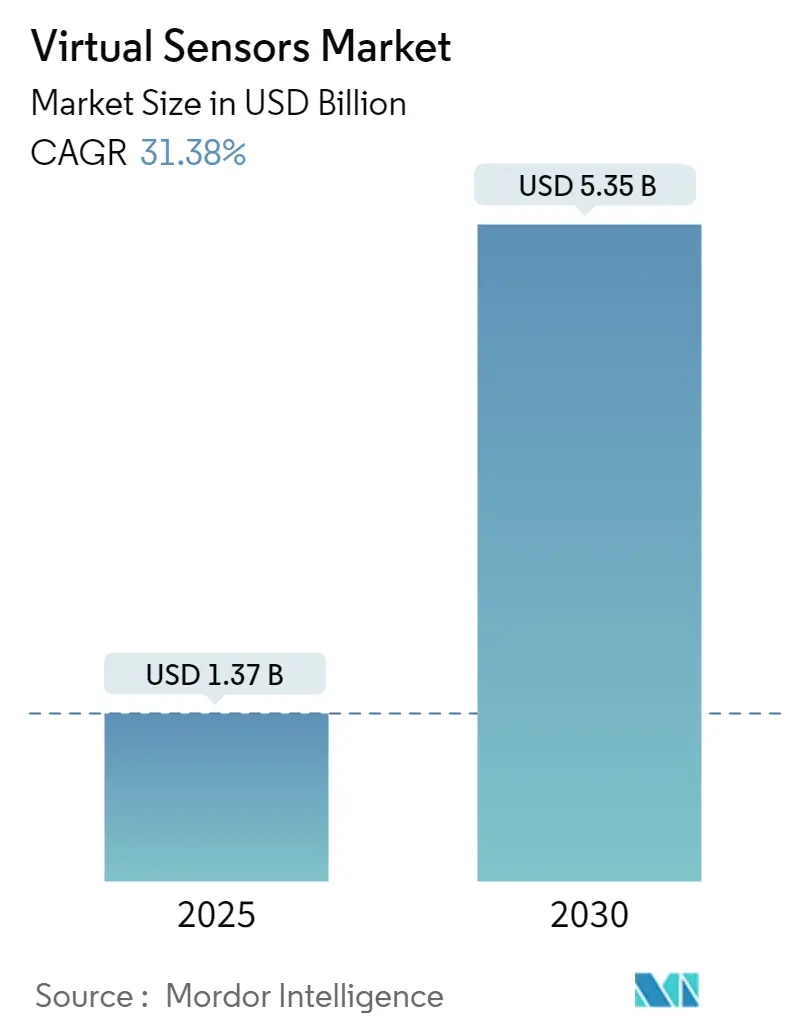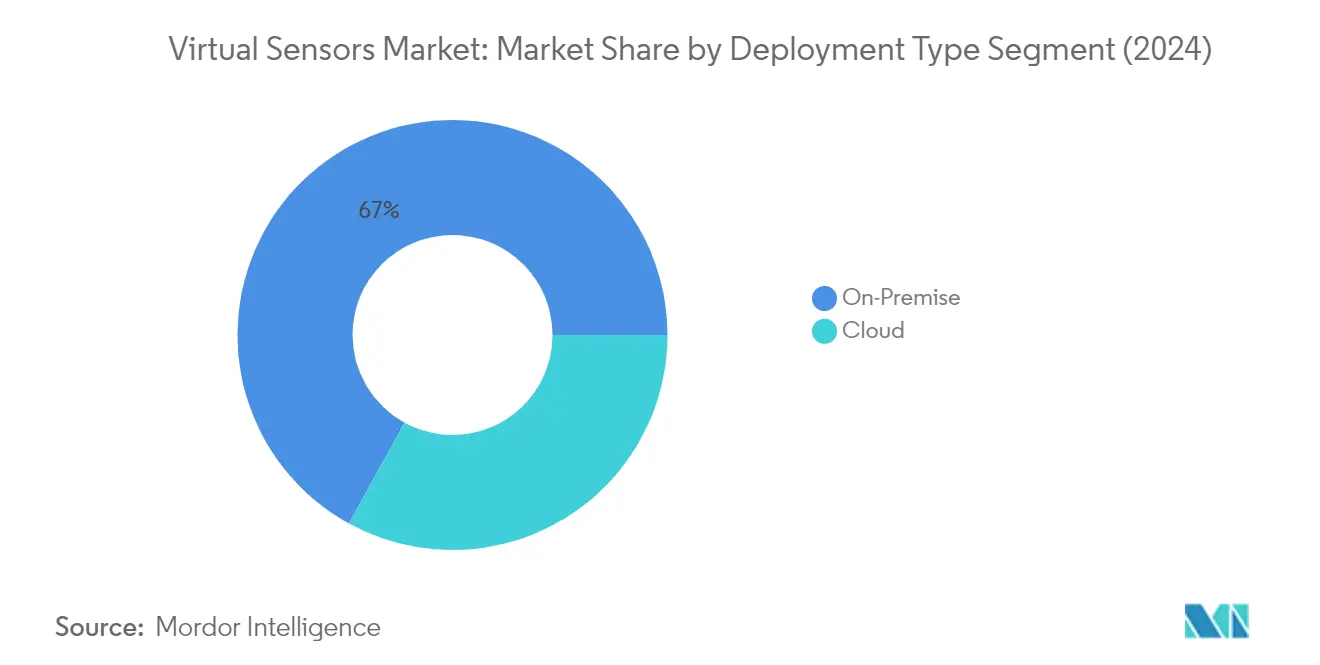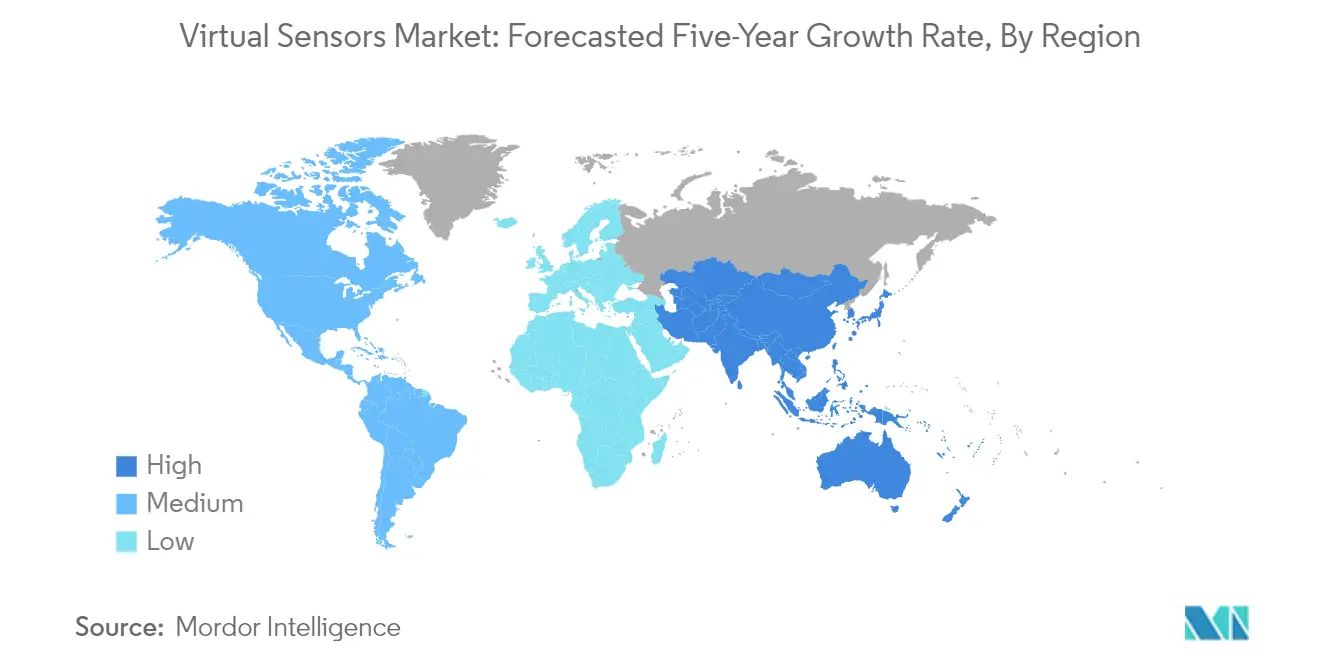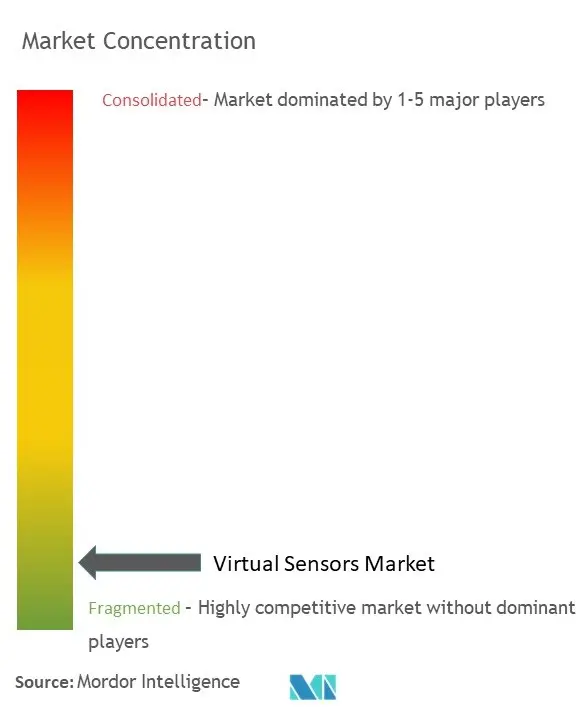Virtual Sensors Market Size and Share

Virtual Sensors Market Analysis by Mordor Intelligence
The Virtual Sensors Market size is estimated at USD 1.37 billion in 2025, and is expected to reach USD 5.35 billion by 2030, at a CAGR of 31.38% during the forecast period (2025-2030).
The virtual sensors industry is experiencing transformative growth driven by the increasing digitalization of industrial processes and the advancement of smart manufacturing technologies. The integration of digital twin sensor technology has become particularly significant, with manufacturers leveraging virtual replicas to optimize operations and enhance predictive maintenance capabilities. According to the International Federation of Robotics (IFR), global industrial robot installations reached 553,052 units in 2022, marking a 5% increase from the previous year, highlighting the growing automation trend that virtual sensors support.
The automotive sector has emerged as a crucial adopter of virtual sensing technology, particularly in developing advanced driver assistance systems (ADAS) and autonomous vehicle capabilities. Virtual sensors are increasingly replacing traditional physical sensors in various vehicle components, including tires, engines, and cabins, offering cost-effective solutions for manufacturers. Intel's projections indicate that global car sales will exceed 101.4 million units by 2030, with autonomous vehicles expected to constitute approximately 12% of car registrations, underlining the growing importance of virtual sensing technology.
The aerospace and defense sector is witnessing significant investments in smart manufacturing and virtual sensor integration. In February 2024, GE Aerospace announced an investment of SGD 15 million to upgrade its aircraft engine repair facility in Singapore into an innovative Smart Factory, demonstrating the industry's commitment to modernizing maintenance practices through virtual sensing technology. These investments are driving the development of more sophisticated virtual sensor applications for aircraft health monitoring and autonomous systems.
Cloud infrastructure development is playing a pivotal role in advancing virtual sensor capabilities across industries. Major cloud service providers are expanding their infrastructure to support the growing demand for virtual sensor deployments. For instance, in January 2024, Amazon Web Services announced plans to invest JPY 2.26 trillion into its cloud infrastructure in Tokyo and Osaka by 2027, which will significantly enhance the capability to deploy and manage virtual sensor systems in the region. This expansion of cloud infrastructure is enabling more sophisticated virtual sensor applications and improving their accessibility across different industries.
Global Virtual Sensors Market Trends and Insights
Increasing Adoption of IoT and Cloud Platforms is Expected to Drive the Market
The proliferation of the Internet of Things (IoT) and cloud platforms is fundamentally transforming the virtual sensors market, creating unprecedented opportunities for market growth. According to Ericsson's Mobility Report 2023, Northeast Asia is leading in cellular IoT connections and is expected to surpass 2 billion connections in 2023. The integration of virtual sensors with IoT devices is enabling enhanced data collection, analysis, and real-time monitoring capabilities across various industries, from manufacturing to healthcare. The combination of IoT and virtual sensors is particularly effective in enabling sustainable change towards decarbonization and digitalization through resource optimization, environmental monitoring, and energy efficiency improvements.
Cloud-based virtual sensing solutions are becoming increasingly prevalent as organizations recognize their numerous advantages. Leading manufacturers are adopting cloud-based virtual sensing as a standard platform, appreciating benefits such as enhanced data connectivity between users and the sensor-cloud server. The cloud platform empowers end-users to reduce overall ownership costs while expanding data storage capabilities. Large amounts of storage and effective computing resources are offered by cloud computing, and resources can be shared across multiple applications through virtualization technology. By combining IoT-WSN with the cloud-based virtualization environment, the traditional network limitations are being eliminated, allowing for more flexible development of new applications.
Growing Need for Enhanced Cost-effectiveness and Operational Efficiency in Manufacturing
The manufacturing sector's increasing focus on cost efficiency and operational optimization is driving significant adoption of virtual sensor technology. According to Capgemini's research, organizations have experienced an average cost reduction of 13% and an increase in operational efficiency of 15% across all digital twin use cases. Automation, propelled by rapid developments in AI, robotics, and machine learning, is significantly lowering labor costs, minimizing errors, reducing waste and downtime, and boosting operational effectiveness. The implementation of virtual sensors in manufacturing processes enables real-time monitoring, predictive maintenance, and optimization of resource utilization.
Governments across regions, including Germany, the United States, China, and India, are actively promoting smart manufacturing techniques through increased automation and industrial control systems. For instance, Germany is focused on the 2030 vision for Industry 4.0 in three strategic fields of action: Autonomy, Interoperability, and Sustainability. The Department of Heavy Industries (DHI) in India is spreading awareness regarding Industry 4.0 to drive Indian Manufacturing to "Smart and Intelligent Manufacturing." These initiatives are creating a favorable environment for virtual sensor adoption, as manufacturers seek to improve productivity and maintain competitiveness in an increasingly automated industry landscape. The integration of virtual sensors with other advanced technologies like AI and machine learning is enabling manufacturers to achieve unprecedented levels of operational efficiency while significantly reducing costs associated with traditional physical sensors.
Segment Analysis: By Deployment Type
On-Premise Segment in Virtual Sensors Market
The on-premise deployment segment continues to dominate the virtual sensors market, commanding approximately 67% market share in 2024. This significant market position is primarily driven by organizations' preference for enhanced control and security over their virtual sensors implementations. On-premise deployments offer organizations greater flexibility to customize sensor monitoring software according to their specific requirements and needs, while maintaining complete physical control over server hardware and software infrastructure. This deployment type is particularly favored in data-sensitive industries where security is paramount, such as finance, military, and healthcare sectors. The segment's dominance is further reinforced by organizations' desire to avoid third-party access and maintain direct control over their data, especially in scenarios where businesses require specific solutions that standard cloud-based services may not offer.

Cloud Segment in Virtual Sensors Market
The cloud deployment segment is emerging as the fastest-growing segment in the virtual sensors market, projected to expand at approximately 34% CAGR from 2024 to 2029. This remarkable growth trajectory is driven by the increasing adoption of cloud-based virtual sensing solutions across various industrial sectors, including healthcare, military, critical infrastructure monitoring, and manufacturing. Organizations are increasingly gravitating towards cloud deployment due to its ease of implementation, high efficiency, and enhanced control capabilities at reasonable costs. The segment's growth is further accelerated by the numerous advantages cloud-based deployment offers, such as improved collaboration capabilities, enhanced data visualization, increased data storage and processing capabilities, and faster response times. The expansion is also supported by vendors actively developing secure cloud solutions to address privacy concerns, with subscription-based private cloud platforms becoming readily available in the market to ensure data security and privacy.
Segment Analysis: By End User Industry
Manufacturing & Utilities Segment in Virtual Sensors Market
The Manufacturing & Utilities segment dominates the virtual sensors market, commanding approximately 30% market share in 2024. This significant market position is driven by the increasing adoption of Industry 4.0 technologies and the growing need for enhanced operational efficiency in manufacturing facilities. Virtual sensing technologies are becoming increasingly crucial in manufacturing operations, enabling real-time monitoring of equipment performance, predictive maintenance, and process optimization. The integration of these soft sensors with existing industrial automation systems has allowed manufacturers to reduce operational costs while improving productivity. Major manufacturing companies are leveraging virtual sensors to create digital twins of their production facilities, enabling better decision-making and process control.
Transportation & Automotive Segment in Virtual Sensors Market
The Transportation & Automotive segment is emerging as the fastest-growing sector in the virtual sensors market, with a projected growth rate of approximately 36% during 2024-2029. This exceptional growth is primarily driven by the increasing adoption of advanced driver assistance systems (ADAS) and the development of autonomous vehicles. Soft sensors are becoming essential components in modern vehicles, enabling various functionalities from collision detection to performance monitoring. The automotive industry's focus on developing more sophisticated autonomous driving capabilities and enhanced safety features is creating a strong demand for virtual sensing technologies. Major automotive manufacturers are increasingly incorporating these smart sensors into their vehicle designs to improve safety, efficiency, and overall performance.
Remaining Segments in End User Industry
The software sensor market encompasses several other significant segments including Oil & Gas, Aerospace & Defense, Electronics & Consumer Technologies, Metal & Mining, and other end-user industries. The Oil & Gas sector utilizes sensor modeling for real-time monitoring and optimization of production processes, while the Aerospace & Defense segment implements these technologies for aircraft performance monitoring and maintenance. The Electronics & Consumer Technologies sector leverages sensor simulation in smart devices and consumer electronics, enhancing user experience and device functionality. The Metal & Mining industry employs machine learning sensor technologies for equipment monitoring and process optimization, while other industries continue to find innovative applications for this technology in their respective operations.
Virtual Sensor Market Geography Segment Analysis
Virtual Sensors Market in North America
North America represents a significant virtual sensors market, driven by extensive adoption of advanced technologies like IoT, cloud computing, and artificial intelligence across various industries. The United States and Canada are the key markets in this region, with both countries showing strong momentum in implementing virtual sensor solutions across manufacturing, automotive, and aerospace sectors. The region's growth is supported by substantial investments in industrial automation, digital transformation initiatives, and the presence of major technology vendors and solution providers.

Virtual Sensors Market in United States
The United States dominates the North American virtual sensors market, holding approximately 90% share of the regional market in 2024. The country's market leadership is driven by its robust technological infrastructure, strong presence of major virtual sensor solution providers, and widespread adoption across various industries. The US market benefits from significant investments in semiconductor manufacturing through initiatives like the CHIPS Act, growing adoption of cloud computing technologies, and increasing implementation of virtual sensors in automotive applications, particularly in Advanced Driver Assistance Systems (ADAS) development.
Virtual Sensors Market Growth Trajectory in United States
As the fastest-growing market in North America, the United States is projected to maintain a growth rate of approximately 30% during 2024-2029. This growth is fueled by increasing smartphone penetration, rising demand for AI-enabled devices, and expanding applications in industrial automation. The country's focus on developing smart manufacturing capabilities, coupled with growing investments in research and development of virtual sensors technologies, continues to drive market expansion. The integration of virtual sensors in various sectors, from consumer electronics to aerospace, further supports this growth trajectory.
Virtual Sensors Market in Europe
Europe represents a mature virtual sensors market, characterized by strong adoption across manufacturing, automotive, and industrial sectors. The region's market is driven by countries like Germany, France, the United Kingdom, and Italy, each contributing significantly to the overall market growth. The European market benefits from strong government support for Industry 4.0 initiatives, a robust manufacturing sector, and an increasing focus on industrial automation and digital transformation.
Virtual Sensors Market in Germany
Germany leads the European virtual sensors market, commanding approximately 28% of the regional market share in 2024. The country's dominance is attributed to its strong industrial base, particularly in the automotive and manufacturing sectors. Germany's commitment to Industry 4.0 initiatives, coupled with significant investments in industrial automation and robotics, has created a favorable environment for virtual sensor adoption. The country's manufacturing sector continues to embrace virtual sensing technology as part of its digital transformation journey.
Virtual Sensors Market Growth Trajectory in Germany
Germany is experiencing the highest growth rate in Europe, with a projected CAGR of approximately 32% during 2024-2029. This growth is driven by increasing adoption of automation in manufacturing facilities, rising implementation of digital twin technology, and growing demand for virtual sensors in automotive applications. The country's strong focus on developing smart factories and commitment to technological innovation continues to fuel market expansion. German manufacturers' emphasis on improving operational efficiency and reducing maintenance costs through virtual sensing solutions further supports this growth trajectory.
Virtual Sensors Market in Asia-Pacific
The Asia-Pacific region represents a dynamic virtual sensors market, with significant contributions from China, Japan, and India. The region's market is characterized by rapid industrialization, increasing adoption of automation technologies, and growing investments in digital transformation initiatives. The market benefits from strong government support for smart manufacturing initiatives, particularly in China and Japan, while India is emerging as a significant market driven by its growing manufacturing sector and digital transformation efforts.
Virtual Sensors Market in China
China dominates the Asia-Pacific virtual sensors market, driven by its massive manufacturing sector and strong government support for technological advancement. The country's leadership in the region is supported by continuous progress in technology and investments in artificial intelligence and IoT. China's commitment to industrial automation, particularly in robotics and smart manufacturing, coupled with initiatives like "Made in China 2025," has created a robust ecosystem for virtual sensor adoption.
Virtual Sensors Market Growth Trajectory in China
China maintains its position as the fastest-growing market in the Asia-Pacific region, driven by rapid industrialization and increasing adoption of smart manufacturing technologies. The country's growth is supported by significant investments in industrial robots, making it one of the most automated countries globally. The expanding presence of domestic robotics manufacturers and growing adoption of IoT-based solutions across various industries continue to drive market expansion.
Virtual Sensors Market in Rest of the World
The Rest of the World market for virtual sensors encompasses regions including the Middle East, Africa, and Latin America. These markets are characterized by growing adoption of virtual sensor technologies across various industries, particularly in oil and gas, manufacturing, and automotive sectors. The market growth is driven by increasing investments in industrial automation, rising adoption of IoT technologies, and growing focus on digital transformation initiatives. The region shows promising growth potential, particularly in countries with strong industrial and manufacturing bases, though the adoption rates vary significantly across different countries and sectors.
Competitive Landscape
Top Companies in Virtual Sensors Market
The virtual sensors market is led by established players like Schneider Electric, Elliptic Labs, Cisco Systems, General Electric, and Siemens AG, who have demonstrated strong capabilities in developing AI-enabled digital twin software and virtual sensing technology solutions. These companies are driving innovation through significant investments in research and development, particularly focusing on advanced AI modeling, machine learning algorithms, and enhanced data security features. The market leaders are expanding their product portfolios through strategic acquisitions of digital twin sensor companies and forming partnerships with industrial IoT integrators. Operational agility is being achieved through cloud-based deployment options and the integration of virtual sensors with existing automation systems. Companies are also focusing on geographical expansion, particularly in emerging markets, while simultaneously strengthening their presence in established regions through robust distribution networks and customer support services.
Mixed Market Structure with Growing Consolidation
The virtual sensors industry exhibits a diverse competitive structure with both large multinational conglomerates and specialized technology providers competing for market share. The larger players, such as General Electric and Siemens, leverage their extensive industrial expertise and global reach to offer comprehensive software sensors solutions integrated with their broader automation and digital transformation portfolios. Meanwhile, specialized players like Elliptic Labs and Modelway SRL focus on developing niche applications and industry-specific soft sensors industry solutions. The market is witnessing increased consolidation through strategic acquisitions, as demonstrated by recent moves from companies like Schneider Electric acquiring AVEVA and Keysight Technologies acquiring ESI Group.
The competitive landscape is further shaped by the emergence of innovative startups focusing on specific industry verticals, such as IntelliSense.io in mining and COMPREDICT GmbH in automotive applications. These companies are gaining traction by offering specialized solutions that address unique industry challenges. The market is characterized by strong partnerships between software sensor companies and cloud platform companies, as well as collaborations with industrial automation integrators to enhance distribution capabilities and technical expertise. This collaborative approach is becoming increasingly important as the market moves toward more integrated and comprehensive digital transformation solutions.
Innovation and Integration Drive Future Success
Success in the AI-enabled sensors market increasingly depends on companies' ability to develop advanced AI modeling capabilities and ensure seamless integration with existing industrial systems. Market incumbents are focusing on expanding their software capabilities through internal development and strategic acquisitions, while also strengthening their distribution networks through partnerships with system integrators and cloud service providers. The ability to provide comprehensive solutions that address specific industry needs, coupled with strong after-sales support and customization capabilities, has become crucial for maintaining market position. Companies are also investing in building expertise in emerging technologies like edge computing and advanced analytics to enhance their sensor virtualization offerings.
For new entrants and smaller players, the path to success lies in developing specialized solutions for underserved market segments and establishing strong partnerships with established industrial automation providers. The market presents significant opportunities for companies that can effectively address industry-specific challenges while maintaining competitive pricing and ensuring robust data security features. The increasing focus on industrial automation and digital transformation across sectors provides a favorable environment for growth, though companies must navigate challenges related to interoperability standards and data privacy regulations. Success will increasingly depend on the ability to provide scalable solutions that can adapt to evolving industrial requirements while maintaining high levels of accuracy and reliability.
Virtual Sensors Industry Leaders
-
Schneider Electric SE
-
Elliptic Labs ASA
-
Modelway SRL
-
Cisco Systems Inc.
-
General Electric Company
- *Disclaimer: Major Players sorted in no particular order

Recent Industry Developments
- March 2024 - Elliptic Labs announced that it has deployed over 500 million devices and is shipping its AI Virtual Proximity Sensor INNER BEAUTY on the Lava Blaze Curve smartphone. Elliptic Labs' newest smartphone customer, Lava International, has released the Lava Blaze Curve smartphone for the international market. Lava has collaborated with Elliptic Labs' partner MediaTek and chosen MediaTek's Dimensity 7050 chipset to drive the Blaze Curve smartphone. Elliptic Labs previously announced the contract for this launch.
- February 2024 - Capgemini and Unity announced an expansion of their strategic alliance, with Capgemini taking on Unity's Digital Twin Professional Services arm. The agreement will see Unity's Digital Twin Professional Services team join and become integrated within Capgemini, creating one of the largest pools of Unity enterprise developers globally. This move aims to speed up the development and deployment of real-time 3D visualization software for industrial digital twin applications.
Global Virtual Sensors Market Report Scope
The sale of virtual sensors in different end-user industries such as manufacturing, oil and gas, transportation and automotive, metal and mining, aerospace and defense, electronics and semiconductor, and other industries across various regions determines the market. Additionally, the analysis monitors the crucial market parameters, fundamental factors that affect growth, and significant industry players to support the evaluation of market size and growth rates during the projected period.
The virtual sensors market is categorized according to deployment type (either cloud-based or on-premise), the industry of the end user (including sectors like oil & gas, manufacturing, transportation and automotive, metals and mining, aerospace and defense, electronics and consumer technologies, among others), and geographic location (covering North America [with specifics on the United States and Canada], Europe [highlighting the United Kingdom, Germany, France, Italy, and the rest of Europe], Asia-Pacific [featuring China, Japan, India, and the rest of Asia-Pacific], and the Rest of the World). This report presents forecasts and the market size in terms of value (USD) for all these segments.
| Cloud |
| On-premise |
| Oil and Gas |
| Manufacturing |
| Transportation and Automotive |
| Metal and Mining |
| Aerospace and Defense |
| Electronics and Consumer Technologies |
| Other End User Industries |
| North America | United States |
| Canada | |
| Europe | United Kingdom |
| Germany | |
| France | |
| Italy | |
| Asia | China |
| Japan | |
| India | |
| Australia and New Zealand | |
| Latin America | |
| Middle East and Africa |
| By Deployment Type | Cloud | |
| On-premise | ||
| By End-user Industry | Oil and Gas | |
| Manufacturing | ||
| Transportation and Automotive | ||
| Metal and Mining | ||
| Aerospace and Defense | ||
| Electronics and Consumer Technologies | ||
| Other End User Industries | ||
| By Geography*** | North America | United States |
| Canada | ||
| Europe | United Kingdom | |
| Germany | ||
| France | ||
| Italy | ||
| Asia | China | |
| Japan | ||
| India | ||
| Australia and New Zealand | ||
| Latin America | ||
| Middle East and Africa | ||
Key Questions Answered in the Report
How big is the Virtual Sensor Market?
The Virtual Sensor Market size is expected to reach USD 1.37 billion in 2025 and grow at a CAGR of 31.38% to reach USD 5.35 billion by 2030.
What is the current Virtual Sensor Market size?
In 2025, the Virtual Sensor Market size is expected to reach USD 1.37 billion.
Who are the key players in Virtual Sensor Market?
Schneider Electric SE, Elliptic Labs ASA, Modelway SRL, Cisco Systems Inc. and General Electric Company are the major companies operating in the Virtual Sensor Market.
Which is the fastest growing region in Virtual Sensor Market?
Asia Pacific is estimated to grow at the highest CAGR over the forecast period (2025-2030).
Which region has the biggest share in Virtual Sensor Market?
In 2025, the Asia Pacific accounts for the largest market share in Virtual Sensor Market.
What years does this Virtual Sensor Market cover, and what was the market size in 2024?
In 2024, the Virtual Sensor Market size was estimated at USD 0.94 billion. The report covers the Virtual Sensor Market historical market size for years: 2019, 2020, 2021, 2022, 2023 and 2024. The report also forecasts the Virtual Sensor Market size for years: 2025, 2026, 2027, 2028, 2029 and 2030.
Page last updated on:



